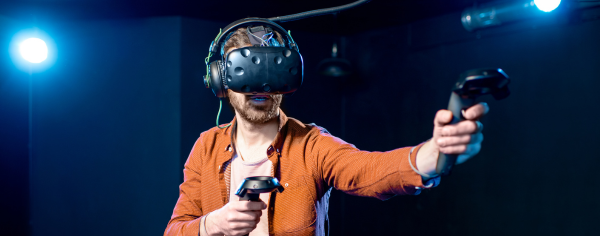Entertain the World with Cutting Edge Gaming Platforms and Software
Augment the playing experience. Augment reality.
How data and power delivery in gaming has evolved
Better, faster, stronger

As gaming software becomes more advanced, so do the requirements of gaming platforms that support them. Major gaming hardware platformers and device OEMs have constantly fought to meet rising demand for high-performance games. The element of console compatibility also further complicates the matter, as companies seek to monopolize popular games through platform exclusivity, but are pushed back by consumers and developers who favor cross-platform compatibility.
A collaborative industry

What we can be sure about, is that developers of smartphones, gaming platforms, and PCs are working closer than ever with major gaming companies to create more entertaining and immersive experiences for end-consumers. Creating balanced, uninterrupted experiences requires stringent optimization of resources to ensure that higher-level data capacity and power delivery requirements are met while ensuring that the unit-cost economics of new platforms remain profitable.
New standards, new norms

Aligning with established industry norms in data capacity and power delivery is the best bet for gaming platform manufacturers who wish to provide consumers with quality assurance. Accomplishing this is easier said than done, as new breakthroughs in AI-powered AR/VR gaming are made every day. But with the help of experts at Authorized Test Labs of GRL, running compliance, certification, and debugging tests for USB power delivery cables and Qi wireless charging has never been easier.
Wired and wireless power delivery
Develop cutting-edge power delivery for gaming platforms with USB certification and Qi certification compliance services.
How big is the worldwide gaming industry?

To say that the gaming industry has captured the imagination of the world would be an understatement. Beyond specialized platforms such as the Nintendo Switch, Playstations, and Xbox, games have evolved to occupy nearly every gap in our lives. The average gamer is estimated to spend over one hour a day gaming, which may not sound like much until you consider that there are 3.2 billion gamers worldwide, a number that is expected to grow beyond 3.8 billion by 2027.
The rise of wearable gaming devices, virtual reality, and the metaverse
The pandemic years saw rapid adoption of gaming consoles among non-gamers as the average individual started looking for ways to entertain themselves while on lockdown. Since then, both gaming platforms and software developers have invested major efforts in delivering more realistic gaming experiences to fulfill various needs, such as the human desire to socialize and maintain an active lifestyle.
Automated test solutions for gaming software & platform development
Connect with gamers anywhere with WiFi
Considering that smartphones are basically handheld computers, an increasing number of casual gamers are turning to smartphones for an affordable and accessible way to engage in social games. Tapping into this market will not only help gaming developers increase their market share, but also provide a new way to engage with new gamers and potentially convert them into more active participants. Smartphones are already an integral part of smart home systems. Integrating games into already-established Bluetooth networks is therefore the next natural step in transforming games into a quintessential part of every household.

Smartphone gaming is an accessible and affordable way for casual gamers to unwind.
Support smartphone and wearable device interoperability with game consoles and TV monitors through Matter certification and testing.
Facilitate the metaverse with connective networks
AAA titles and gaming platform developers have already rolled out games on VR devices such as the Oculus and PlayStation-VR that are enjoyed by millions around the world. Strong, consistent connectivity is even more pertinent with virtual reality when it comes to maintaining the illusion, which is why developers are tapping into wired USB3.0 connectivity as well as wireless networks such as Bluetooth and WiFi to ensure that all moving parts within virtual reality games function as they should.

Metaverse platforms allow users to explore and interact with novel digital environments from the safety of their home.
This transition means that traditional gaming controllers and joysticks will be phased out to make way for motion sensors. For example, Sony has already released a proprietary motion sensor for users to gain access into the Metaverse. This trend towards Augmented Reality (AR) will likely grow as consumers grow more accustomed to engaging with gaming systems more actively than before.
Create an immersive metaverse experience with leading wireless network and IoT test services and solutions.
Store and manage user data of gamers worldwide
Also growing alongside augmented and virtual reality is the live streaming industry. Valued at $1.23 billion in 2022, this form of social gaming is on track to generating over $2.6 billion in total revenue by 2031 as users worldwide watch popular influencers play their favorite games in new and innovative fashion over ubiquitous mobile devices and smartphones. Running behind the scenes of this new way of connecting are cloud servers that will require more efforts to scale and maintain. Gaming platforms and developers will therefore need to upgrade their inter-board connection to PCIe gen5 or gen6 to match up with new standards in speed and data bandwidth.

Motion sensors allow gamers to manipulate digital characters according to the movements of their body
Allow for seamless storage and access of user gaming data with up-to-date PCIe systems made possible with robust PCIe compliance and testing.
Only the latest news
Always stay at the forefront of cutting-edge technology when you subscribe to the GRL newsletter.
GRL gaming-related testing services
Assess your wearable gaming devices and display interfaces reliably to create the ultimate immersive entertainment experience.


/%E5%BE%9E%20VESA%20%E8%BF%91%E6%9C%9F%E9%87%8B%E5%87%BA%E7%9A%84%E6%96%B0%E8%A6%8F%E7%AF%84%20(DisplayPort%202.1%E3%80%81ClearMR%E3%80%81AdaptiveSync)%20%E6%B4%9E%E5%AF%9F%E5%85%A8%E7%90%83%E5%BD%B1%E9%9F%B3%E8%B6%A8%E5%8B%A2.png?width=750&height=500&name=%E5%BE%9E%20VESA%20%E8%BF%91%E6%9C%9F%E9%87%8B%E5%87%BA%E7%9A%84%E6%96%B0%E8%A6%8F%E7%AF%84%20(DisplayPort%202.1%E3%80%81ClearMR%E3%80%81AdaptiveSync)%20%E6%B4%9E%E5%AF%9F%E5%85%A8%E7%90%83%E5%BD%B1%E9%9F%B3%E8%B6%A8%E5%8B%A2.png)


